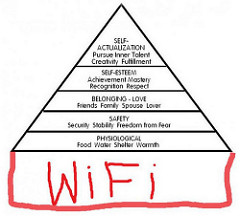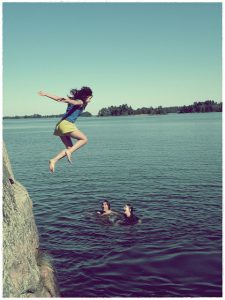For this assignment, I was asked to interview, transcribe and analyze a conversation with a math or science teacher with regards to their technology use in the classroom.
Link to my transcript is here.
Background:
“Brianna” has been teaching a variety of subjects for 14 years, including junior Science, senior Biology, P.E., “Reconnecting Youth” (a program for at-risk students) and Yearbook. Presently, she is teaching Science 9 and Biology 12 at a large high school. As Brianna and I have young children at home, and she teaches at a different high school than mine, I conducted the interview via Google Hangouts, at 9 p.m., January 18. (This was a less than ideal time to interview—both of us were exhausted!) I asked Brianna to be my subject for two reasons. 1. There is only one other person in Math or Science at my school who uses any technology and she was spread so thin this week, you could see through her. 2. Bri and I have worked together for 13 years, but last year, she was bumped to another school due to seniority. This summer, I gave her a Google Classroom 101 class in my kitchen, so I was eager to see how she was coming along!
Collaboration
When prompted to respond about current technology enhanced processes Brianna uses, the commonality to every response was sharing information between groups of people.
Reading other interviews, this was a common theme amongst technology users. What surprises me somewhat, is that although many of us are participating in collaborative processes via our Masters’ work, not as many of us have incorporated similar approaches in our own classrooms. Reasons for this may include having restricted access to one-to-one technology, school districts may not be buying into the GAFE model and lack of time to learn or make make large pedagogical shifts. Having access to reliable wi-fi, is another major issue that is affecting schools nationally. Talking to our IT guru this week, even within our school district, there is a huge disparity between individual schools. Because high schools in British Columbia are funded on a PER BLOCK basis, the more students taking the more courses, results in more funding for that particular school. As overhead for running a school of 500 students is not much different as the overhead for 750 students, the school with 50% more bodies, can easily pay for their overhead and have money to spend on other things. The bottom line, is that in Victoria, the large schools have enough bandwidth and the small schools do not.


This work is licensed under a Creative Commons Attribution 2.0 Generic License.
Risk Taking
Brianna provided me with two “wow moments” in this interview. The first came from her anecdote about a student who was so anxious about using the Google Classroom platform for assignments, that the student brought herself to tears. Identifying this student in the first week of class, via a digital Interest Inventory on Google Forms was critical. Brianna’s limited experience with this platform, was balanced by her many years in the classroom, so she knew to address this student’s concerns immediately and with compassion. Allowing the student an alternative to the technology would have validated the student’s fears, thereby strengthening those fears. Instead, Brianna provided her with a safe and scaffolded process, that demystified the technology for the student, and the student went on to a successful and enjoyable semester.
So if some educators are demanding that their students take huge leaps in their digital literacy acquisition, why can it be so unbearable for other educators to even take a baby step? Other interviews reported teachers feeling helpless with their technology due to lack of training. Conferences such as GAFE, cost hundreds of dollars and not everyone is prepared to invest. Moreover, when I have given Professional Development to the entire staff, it has been with mixed reviews! People can feel threatened by overwhelming feelings of confusion, inadequacy, or anger, when new ideas are brought to the table that may not be in their wheelhouse. After having a colleague have a near panic attack in my Twitter 101 talk at a Pro-D five years ago, I learned very quickly that when it comes to technology training, it is best to lure certain folks to you, as opposed to cornering them in a staff meeting. Everyone’s relationship with technology is very different and very personal— it is prudent to individualize learning situations, whenever possible! Personally, I would love to research more about providing Pro-D in a variety of different formats. As with our students, colleagues will be more receptive to new modalities when they are calm and have trust in their instructor.
Although I need to work on my interview skills (at times, I was so awkward, that I wanted to go into the fetal position!), Brianna’s last quote is absolute gold. How can we, as teachers, as parents, as just plain people, preach to others, to act a certain way, or think a certain way, if we, ourselves, are not prepared to do so?
“Assignments, so I created an assignment, for example we did this thing like the Genius Hour, but not— we did this project and I had it set up into three parts and so each part we did a check-in so that I could see what they were doing and when they decided to work in groups then they would share that with their group members so that all 3 of us could look at it. And with teachers, we are working on, well there’s 3 of us working on a brand new Biology 12 lab and so we have the Doc at the same time each doing different parts and seeing what the other people are working on, and adding feedback and comments and stuff like that.”“I think that one of the things is about group projects… one student was sick and the other student was upset because they weren’t there doing their part. But they were able to talk using the comments on the Docs, right on the document.”
“I don’t have to worry about the TOC because I can post everything on there and the kids know exactly what they are supposed to do and I can come up with something on the fly and stick it up for them to do. Just attaching it from the Drive, without worrying about photocopying or where it is on my desk— I just stick it on the Classroom.”
“An interesting one with a student who was really anti-technology and her like misconception about technology she was only thinking about it as like using a cell phone all the time— so she was really scared and was in tears…. throughout the semester, she ends up adapting to the technology and once she adapted, she got over the fear of using it.”
“As teachers, we always want things to be organized and planned. But this is not going to be perfect, and you just have to jump in. We want our kids to take chances and be brave, so you have to take chances and be brave.”


This work is licensed under a Creative Commons Attribution 2.0 Generic License.
